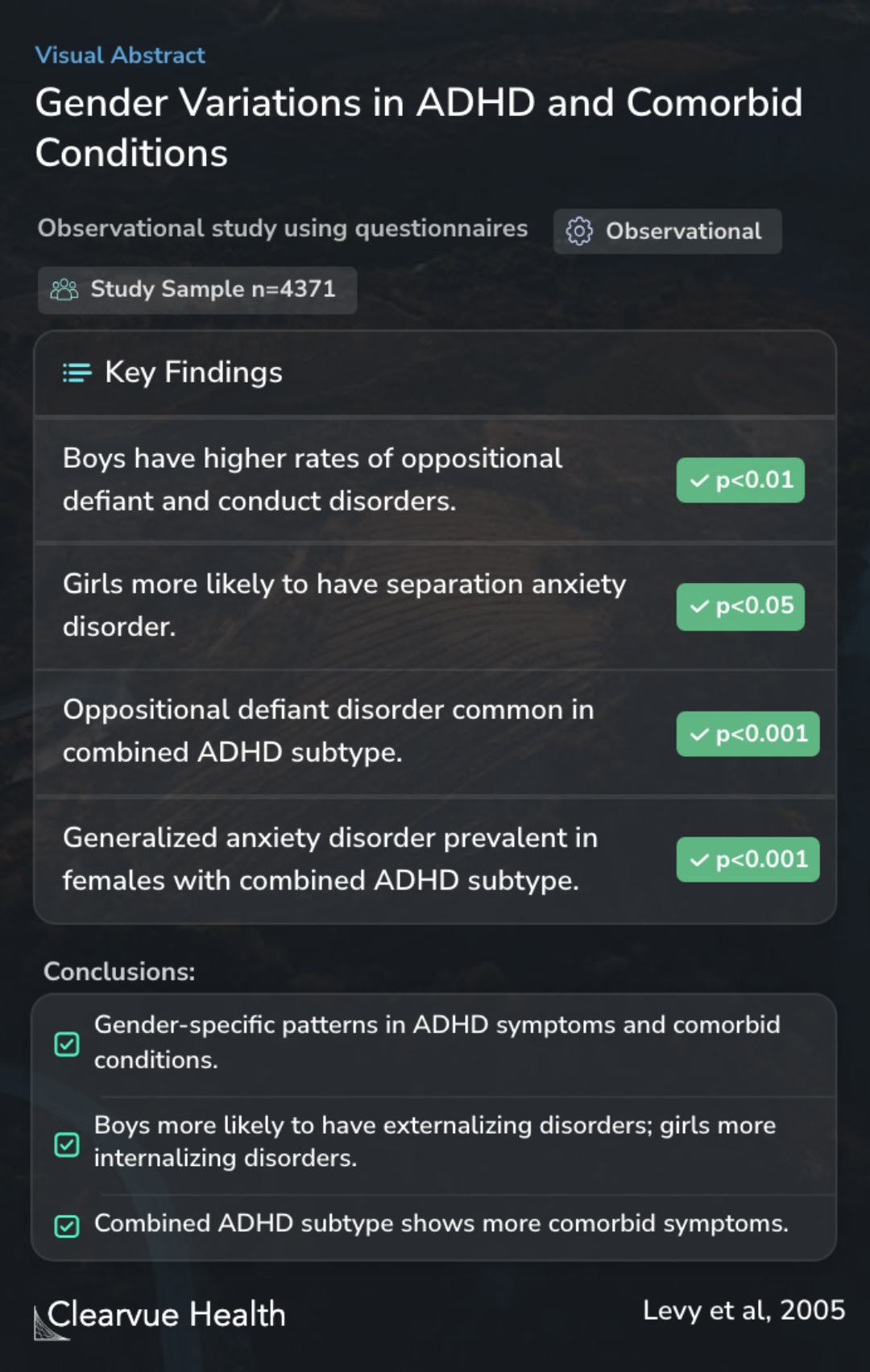Gender differences in ADHD subtype comorbidity
Gender Variations in ADHD and Comorbid Conditions
Levy F, Hay DA, Bennett KS, McStephen M

Objectives
The study aimed to explore how ADHD symptoms are linked with other conditions like oppositional defiant disorder, conduct disorder, separation anxiety disorder, generalized anxiety disorder, speech therapy needs, and remedial reading in kids. This is crucial because ADHD doesn't just stand alone; it often comes with challenges.
Objective: To examine gender differences in attention-deficit/hyperactivity disorder (ADHD) symptom comorbidity with oppositional defiant disorder, conduct disorder, separation anxiety disorder, generalized anxiety disorder, speech therapy, and remedial reading in children.
Methods
The authors collected data from a big group of twins and siblings, totaling 4,371 participants, as part of the Australian Twin ADHD Project. They sent out questionnaires based on the DSM-IV, which is a guide doctors use to diagnose mental disorders, to study different types of ADHD and how they come with other conditions. They got back 1,550 of these questionnaires throughout 12 to 18 months. This method allowed them to gather detailed information about ADHD in a large, diverse group.
Method: From 1994 to 1995, data from a large sample (N = 4,371) of twins and siblings studied in the Australian Twin ADHD Project were obtained by mailed DSM-IV-based questionnaires, investigating patterns of comorbidity in the three subtypes of ADHD: inattentive, hyperactive/impulsive, ...
Results
The study found some key differences between boys and girls when it comes to ADHD. Boys were more likely to have issues like oppositional defiant disorder and conduct disorder. On the other hand, girls were more likely to face challenges like separation anxiety disorder. These findings suggest that internalizing disorders, where problems are directed inward, are more common in girls, while externalizing disorders, where disruptive behaviors are directed outward, are more common in boys. The authors also noticed differences among the ADHD subtypes. For instance, the combined subtype of ADHD, which includes both inattention and hyperactivity/impulsivity, was linked to more of these other conditions in kids.
Results: Analysis of variance showed significant between-group differences in males and females for inattention and hyperactive/impulsive symptom counts with higher rates of oppositional defiant disorder and conduct disorder in males, and higher rates of separation anxiety disorder in fe...
Conclusions
The study reveals that while ADHD comes with different challenges for boys and girls, there weren’t significant gender differences in terms of externalizing disorders. The paper suggests that girls with inattentive ADHD might often experience anxiety.
Conclusions: Although comorbidity differs among ADHD subtypes, there were no significant gender differences in comorbidity for externalizing disorders. Inattentive girls may present with anxiety. Clinical approaches for both males and females should be sensitive to possible language and ...
Key Takeaways
Context
Linking this study to broader research, a study by Sobianski et al. in 2007 showed that adults with ADHD faced higher risks of psychiatric disorders and struggled with everyday life. This aligns with the current study’s findings, emphasizing the long-term impact ADHD can have on mental health and daily functioning. It's clear that ADHD isn't just about being hyper or distracted; it can significantly affect a person's life and mental well-being.
Another study by Ohlmeier et al. in 2008 found a link between ADHD symptoms in adults and substance abuse, like heavy drinking and drug use. This suggests that some adults might be using substances to cope with undiagnosed ADHD symptoms they've had since childhood. This ties back to the current study's emphasis on understanding the various impacts of ADHD, as early recognition and treatment could potentially prevent such long-term issues.